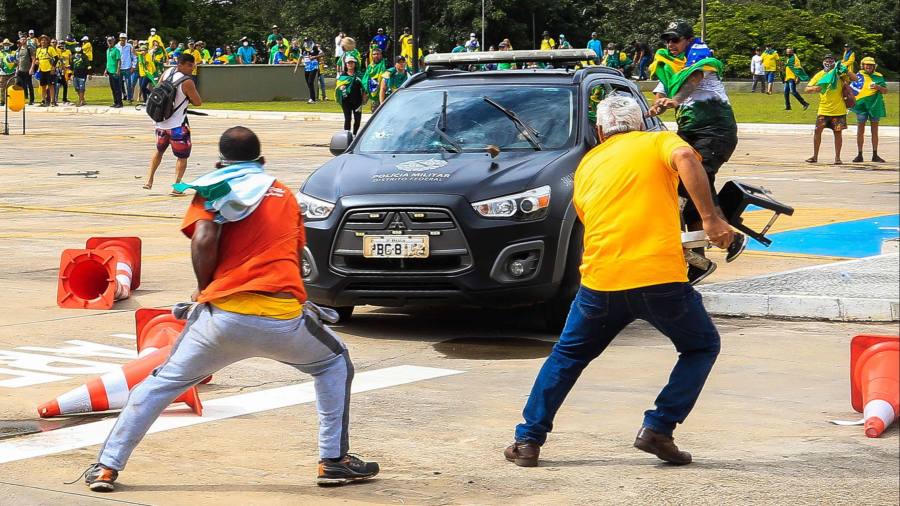There are many parallels between the January 6 attack on the US Capitol in 2021 and the January 8 insurrection in Brasília two years later — not least, that investors appeared happy to initially shrug them both off.
Look at a chart of the S&P 500 equity index in January 2020, and the storming of the seat of the US Congress is barely detectable. Brazilian stocks rose on January 9, the first trading day after Sunday’s riot. Such insouciance may turn out to be misplaced. Investors would be right to wonder what lasting effects might play out in Brazil.
It is a truism that, for emerging markets, external factors matter more than domestic ones. For at least the past year, EM stocks, bonds and currencies, like other risky assets, have been driven by the Federal Reserve. For much of 2022, as US interest rates and the dollar rose, EM assets fell. For the past three months, the prospect of a relaxation in US monetary policy has driven EM stocks into a bull market. In Brazil’s case, and in many others, you can add global commodity prices as a driver of local stocks and bonds.
But domestic conditions matter, too. Since September 2020, when optimism over a post-pandemic rebound in Brazil fizzled out, investors have turned against the country’s stocks. Shares in the benchmark Bovespa index are now trading at just seven times forward earnings, a 36 per cent discount to their average of the past 10 years.
Investors have been spooked by concerns of fiscal largesse and the danger that it will cause persistent inflation and financial instability, as it has so often in the past. Before Sunday’s shocking events, they worried that Brazil’s two-time president, Luiz Inácio Lula da Silva, the former union leader, would fail to meet his pledge of fiscal responsibility.
After Sunday’s events, they may feel that a difficult job has been made a lot harder. Risk consultancy Verisk Maplecroft said the riots were certain to undermine market confidence in Brazil and that “the long-term fragility of Lula 3.0 has been exposed”.
That depends. In the short term, the rioting has given Lula a boost. Joe Biden, the US president, called to offer solidarity and an invitation to Washington next month, which Lula accepted. Many Brazilians were repulsed by the televised scenes of vandalism in the modernist artwork that is Brasília.
Lula’s political capital is enhanced. His new government was expected in the coming days to present measures to Congress to help offset a $32bn expansion of public spending pushed through the legislature by his transition team last month. If that happens quickly, investors will be relieved.
Any delay, and they could be unnerved. Alberto Ramos, Latin American economist at Goldman Sachs, says the new spending commitments will help tip the budget balance from an estimated surplus of 1.3 per cent of gross domestic product in 2022 to a deficit of at least 1.4 per cent this year, while adding between 3 and 4 percentage points to the ratio of government debt to GDP.
That would mark a significant reversal of recent progress. According to the Institute of International Finance, an industry association, public debt fell from almost 99 per cent of GDP in early 2021 to 89 per cent by the middle of last year.
The greater threat comes in the medium to long term. Lula won October’s election by the narrowest of margins, showing how deeply polarised Brasil has become. If the economy performs badly — and growth is certainly slowing this year — he will be less willing or able to push for unpopular reforms, especially any designed to raise government revenues or cut spending.
Many foreign investors will stay focused on the big picture of the Fed and commodities. Brazil’s central bank reassured many by acting early and aggressively to tackle inflation, embarking on a tightening cycle that took its policy rate from 2 per cent to 13.75 per cent. And since July 2020, the yield on Brazil’s 10-year local currency government bonds has more than doubled to 12.7 per cent. When interest rates start to fall, that will boost bond prices.
“A good rule of thumb is to go with the flow on central bank policy and Brazil’s central bank is the one people expect to lead interest rate cuts in 2023,” said David Hauner, strategist at Bank of America Securities. “A lot of investors have put a lot of money on that trade.”
But much will depend on the new government’s full fiscal plans it has promised to present by April. If Lula is seen to be steering public finances into better shape, that might reassure investors that the central bank will be able to cut earlier rather than later. Otherwise, foreign investor confidence will falter.
Read the full article here



